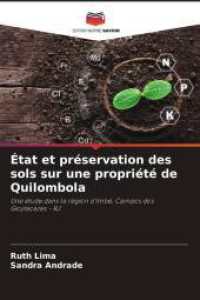- ホーム
- > 洋書
- > 英文書
- > Science / Mathematics
Full Description
This handbook provides an insight into the advancements in surface engineering methods, addressing the microstructural features, properties, mechanisms of surface degradation failures, and tribological performance of the components. Emphasis is placed on the use of laser cladding methods because they make it simple to deposit new classes of materials such nano-composites, nanotubes, and smart materials.
Handbook of Laser-Based Sustainable Surface Modification and Manufacturing Techniques discusses the main mechanism behind the surface degradation of structural components in strenuous environments. It highlights the capacity of laser cladding to operate on a wide range of substrate materials and shapes as well as presents how laser cladding can offer new possibilities in the reconditioning of components and how, in many cases, these approaches are the only solution for economic efficiency. The handbook illustrates how the type of laser, laser optics, and the parameters of the process can be efficiently selected, and thus the number of applications of laser cladding and its applications can be increased. The standard methods of testing used for various types of biomedical devices and tools, as well as the advantages of combining laser cladding with simultaneous induction heating, are described as well within this handbook.
Features:
Discusses the role of claddings fabricated with laser technique to withstand wear and corrosion
Highlights the role of laser in the manufacturing of alloys and recent advancements in laser based additive manufacturing processes
Presents the possibilities, applications and challenges in laser surfacing
Illustrates the post-treatments of powders and coatings and case studies related to laser surface technology
Offers the standard methods of testing applied to various types of biomedical devices and tools
Goes over the advantages of combining laser cladding with simultaneous induction heating
The technical outcomes of these surface engineering methods are helpful for academics, students, and professionals who are working in this field, as this enlightens their understanding of the performance of these latest processes. The audience is broad and multidisciplinary.
Contents
1. Application of Wear -Resistant Laser Claddings. 2. Application of Corrosion-Resistant Laser Claddings. 3. A Comprehensive Analysis of Recent Advancements and Future Prospects in Laser-Based Additive Manufacturing Techniques. 4. Microstructure and Characteristics of Alloys Produced by Additive Laser-Based Manufacturing Technique. 5. Laser Surface Engineering: State of the Art, Applications and Challenges. 6. Laser Surface Engineering: Case Studies. 7. Applications of Laser Technology for Processing and Post-Treatments of Powders and Coatings. 8. Sustainability Issues in Laser-Based Additive Manufacturing.








